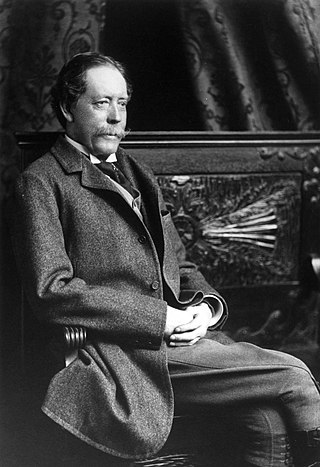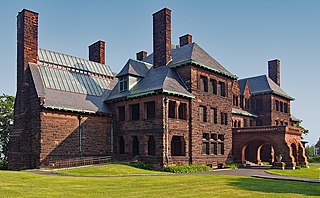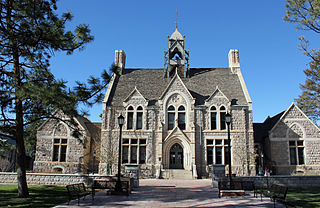
Manitou Springs is a home rule municipality located at the foot of Pikes Peak in western El Paso County, Colorado, United States. The town was founded for its natural mineral springs. The downtown area continues to be of interest to travelers, particularly in the summer, with many shops and restaurants, as well as a creekside city park. The main road through the center of town was one of the direct paths to the base of Pikes Peak. Barr Trail, which winds its way up Pikes Peak, is accessible from town. The subdivision Crystal Hills was added to the municipality in the 1960s.

William Jackson Palmer was an American civil engineer and veteran of the American Civil War. During the Civil War, he was promoted to brevet brigadier general and received a Medal of Honor for his actions.

Scotty's Castle is a two-story Mission Revival and Spanish Colonial Revival style villa located in the Grapevine Mountains of northern Death Valley in Death Valley National Park, California, US. Scotty's Castle is named for gold prospector Walter E. Scott, although Scott never owned it, nor is it an actual castle.

The Montezuma Castle is a 90,000-square-foot (8,400 m2), 400 room Queen Anne style hotel building erected just northwest of the city of Las Vegas, New Mexico in 1886. The current castle is actually the third on the site, the first two were the first buildings in New Mexico to have electric lighting, and they both burned down.

The Bishop's Palace, also known as Gresham's Castle, is an ornate 19,082 square feet (1,772.8 m2) Victorian-style house, located on Broadway and 14th Street in the East End Historic District of Galveston, Texas.

The James J. Hill House in Saint Paul, Minnesota, United States, was built by railroad magnate James J. Hill. The house, completed in 1891, is near the eastern end of Summit Avenue near the Cathedral of Saint Paul. The house, for its time, was very large and was the "showcase of St. Paul" until James J. Hill's death in 1916. It is listed as a U.S. National Historic Landmark, operated by the Minnesota Historical Society. It is also a contributing property to the Historic Hill District.

The Colorado Springs School District 11 is the central school district of Colorado Springs, Colorado. Its headquarters are in that city.

Before it was founded, the site of modern-day Colorado Springs, Colorado, was part of the American frontier. Old Colorado City, built in 1859 during the Pike's Peak Gold Rush was the Colorado Territory capital. The town of Colorado Springs was founded by General William Jackson Palmer as a resort town. Old Colorado City was annexed into Colorado Springs. Railroads brought tourists and visitors to the area from other parts of the United States and abroad. The city was noted for junctions for seven railways: Denver and Rio Grande (1870), Denver and New Orleans Manitou Branch (1882), Colorado Midland (1886-1918), Colorado Springs and Interurban, Atchison, Topeka, and Santa Fe (1889), Rock Island (1889), and Colorado Springs and Cripple Creek Railways. It was also known for mining exchanges and brokers for the Cripple Creek Gold Rush.

The Palmer House is a historic hotel in Sauk Centre, Minnesota, United States. It was built in 1901 and expanded in 1916. The hotel was listed on the National Register of Historic Places in 1982 for having local significance in the themes of commerce and social history. It was nominated for being an example of a once-common hotel type catering specifically to traveling salesmen. In 1994 the Palmer House was also listed as a contributing property to the Original Main Street Historic District.

Briarhurst Manor, also known as William A. Bell House, is a finely grained pink Victorian sandstone manor house listed on the National Register of Historic Places in the city of Manitou Springs, Colorado. It is the second building on this site.

Redstone Castle, also known as Cleveholm or Osgood Castle, is a mansion south of Redstone, Colorado, United States. It is a large timber frame structure built in the early 20th century as the home of John C. Osgood, founder of the Colorado Fuel and Iron Company, in a simplified version of the Stick style. In 1971 it was added to the National Register of Historic Places, the first property in Pitkin County to be listed. It was later additionally listed as a contributing property to the Redstone Historic District.

The Waldo Canyon fire was a forest fire that started approximately 4 miles (6.4 km) northwest of Colorado Springs, Colorado on June 23, 2012, and was declared 100 percent contained on July 10, 2012, after no smoke plumes were visible on a small portion of the containment line on Blodgett Peak. The fire was active in the Pike National Forest and adjoining areas, covering a total of 18,247 acres. The fire had caused the evacuation of over 32,000 residents of Colorado Springs, Manitou Springs and Woodland Park, several small mountain communities along the southwestern side of U.S. Highway 24, and partial evacuation of the United States Air Force Academy. There were 346 homes destroyed by the fire. U.S. Highway 24, a major east–west road, was closed in both directions. The Waldo Canyon Fire resulted in insurance claims totaling more than US $453.7 million. It was the most destructive fire in Colorado state history, as measured by the number of homes destroyed, until the Black Forest Fire surpassed it almost a year later when it consumed 486 homes and damaged 28 others.

Manitou Springs Historic District in Manitou Springs, Colorado is roughly bounded by US 24, Ruxton Avenue, El Paso Boulevard and Iron Mountain Avenue. Listed in the National Register of Historic Places, it is one of the country's largest National Historic Districts.
Thomas MacLaren was a Scottish architect. He was educated at the Kensington School of Art in Edinburgh and the Royal College of Art. After completing his education, MacLaren worked in London, and then moved to the United States for his health. He first lived in Denver, Colorado, and then Colorado Springs, Colorado, where he worked from 1894 until 1928.

The Cutler Hall is a Gothic library building on the Colorado College campus in Colorado Springs, Colorado. The building is on the National Register of Historic Places.

The Eastholme, also known as Eastholme of the Rockies, is a historic building in Cascade, near Colorado Springs, Colorado. It is on the National Register of Historic Places.

Taylor Memorial Chapel at La Foret Conference and Retreat Center is a historic chapel in Black Forest, Colorado. It is a National Register of Historic Places listing.

The Antlers is a Wyndham Hotel located in Colorado Springs, Colorado. It opened in 1967 and is the third hotel of that name on the same site.
Queen′s Canyon is a moderate hiking trail which crosses Glen Eyrie private property on the west side of Colorado Springs, near the North entrance to Garden of the Gods park. The trail is known for Dorothy Falls and five granite pools filled with mountain water, known collectively as the punch bowls. The first half of this trail is a wood-planked path that hugs walls of the gorge.



















